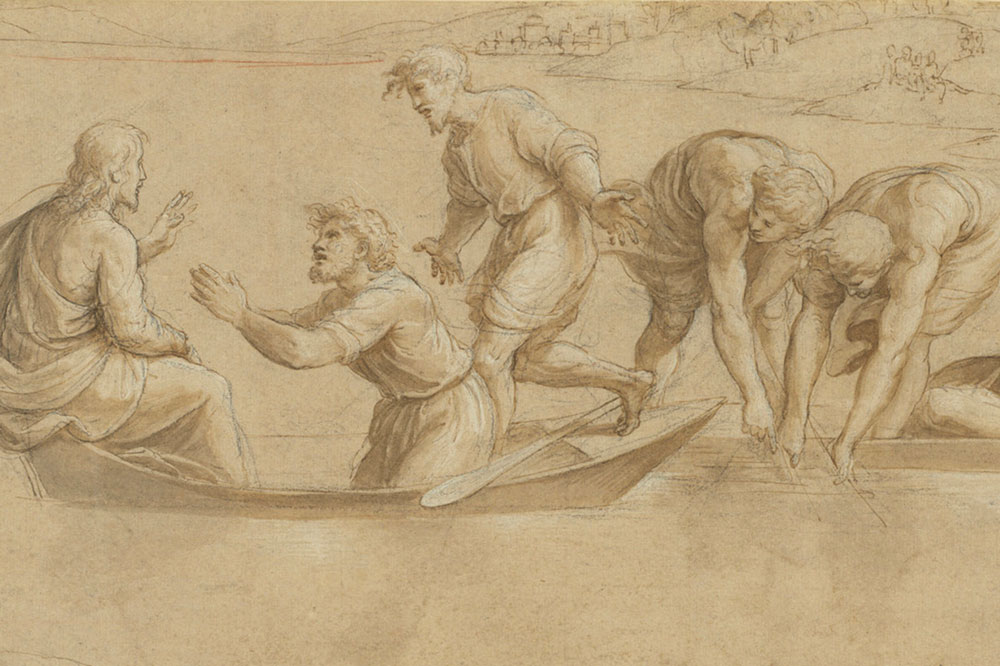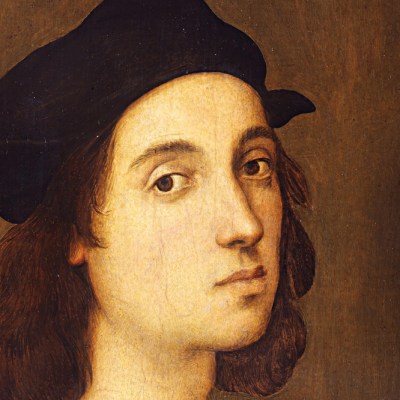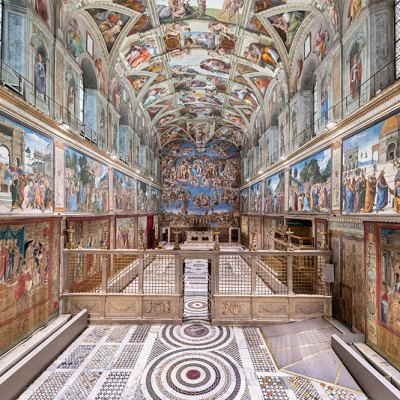The Lightbox in Woking has earned a reputation for innovative exhibitions and this show about Prince Albert’s fascination with Raphael – staged to mark the 500th anniversary of the artist’s death – does not disappoint. Passing a marble bust of the Prince Consort (1819–61), the visitor enters an airy gallery dominated by a Mortlake tapestry of Raphael’s Miraculous Draught of Fishes. Made around 1670, probably for Boughton House, this is based on one of the celebrated Raphael Cartoons. These giant watercolours of the lives of saints Peter and Paul were commissioned in 1515 by Pope Leo X as designs for 10 tapestries which were made for the Sistine Chapel and are now in the Vatican Museums. The seven surviving cartoons were bought by Charles I in 1623 to serve as models for the tapestry manufactory in Mortlake in south-west London. Since 1865 they have been on loan from the Royal Collection to the South Kensington (now Victoria and Albert) Museum.
The show’s principal exhibits are prints and early photographs of Raphael’s designs for The Miraculous Draught of Fishes and Christ’s Charge to Peter from the Print Room at Windsor Castle. The Raphael Collection there is a unique resource of around 5,000 images in 49 portfolio boxes housed in an ornate cabinet designed in 1861 by J.G. Crace. An ‘imaginary museum’ of every known work by or after Raphael and his circle, it also provides a history of reproduction techniques from the High Renaissance to Victorian times.
The Miraculous Draught of Fishes (c. 1514), attrib. to Raphael. Royal Collection Trust/© Her Majesty Queen Elizabeth II 2020

The Prince Consort had studied art history while a student at the University of Bonn and made the Grand Tour in 1838–39. His fascination for Raphael was shared by his German contemporaries: Ludwig I of Bavaria purchased three paintings by the artist between 1809–29 and five more entered the royal collection at Berlin between 1821–54. In 1858 Frederick William IV of Prussia opened a ‘Raphael Pantheon’ in the orangery at his palace in Potsdam, comprising more than 50 full-size copies of the master’s most famous works.
When Albert began to reorganise the Royal Collection in the early 1850s, one of his first priorities was Raphael, then generally considered the greatest Old Master. He was assisted by the royal librarian Dr Ernst Becker, a keen photographer; his successor Carl Ruland completed a catalogue of the Raphael Collection in 1876. Photography was undertaken by Charles Thurston Thompson from the South Kensington Museum. His most challenging task was, in 1858, to photograph the Raphael Cartoons, then at Hampton Court. This was done out of doors to obtain sufficient natural light, using three-foot-wide glass negatives in a camera 12 feet long, which ran on a small tramway. The results were praised as ‘all but as valuable as the originals’.
The exhibition includes a fascinating albumen print of The Miraculous Draught of Fishes, inscribed with condition notes made by Richard Redgrave, the Surveyor of the Queen’s Pictures, before the cartoon left Hampton Court. Another shows the huge packing case and horse-drawn van that transported these fragile masterpieces, on rubber slings to reduce vibrations, to South Kensington.
After Raphael – The Miraculous Draught of Fishes (1858), Charles Thurston Thompson. Victoria and Albert Museum, London.

An adjoining display space is painted a sumptuous crimson as a ‘mini-Tribuna’ for the show’s star turn – four Raphael drawings from the Royal Collection. The first is a modello for The Conversion of the Proconsul that was copied in 1516 as the earliest engraving of the Raphael Cartoons, by Agostino Veneziano. There follows a study for The Miraculous Draught of Fishes and an offset from a red-chalk drawing for Christ’s Charge to Peter, showing Raphael’s studio assistants posed in the attitudes of the draped figures in the final design. This was doubtless made to test the composition in reverse, as it would appear in the tapestry. The last is a study for the personification of Florence in the fictive bronze relief in the decorative border of The Stoning of Stephen, a tapestry whose full-scale cartoon is now lost.
The final section of the show, which reveals Raphael’s influence on Victorian artists, begins with an ink copy by the queen herself after a nude study by ‘the Prince of Painters’. In Victoria’s bedroom at Osborne House hung William Dyce’s Madonna and Child, painted in 1845, which she described in her journal as ‘in the style of Raphael – so chaste & exquisitely painted’. Its crisp style and that of its companion piece Saint Joseph recall the work of the German Nazarene painters whom Dyce likely met in Rome.
Madonna and Child (1845), William Dyce. Royal Collection Trust/© Her Majesty Queen Elizabeth II 2020

The Renaissance master also impressed the photographer Julia Margaret Cameron, who subtitled several of her works as ‘after the manner of Raphael’. The pale veil and drapery of the albumen print of her housemaid posed as the Virgin Mary, titled La Madonna della Pace (1864), recall Raphael’s resplendent Donna Velata (Pitti Palace), which Vasari identified as a likeness of the artist’s lover. Similarly, Cameron’s photograph of an angelic child with folded arms, taken in 1872, is based on Raphael’s most reproduced painting, The Sistine Madonna, in Dresden. Oscar Rejlander’s photomontage The Two Ways of Life, made in 1857, is represented at Woking by a later copy print. This allegorical subject was inspired by Raphael’s School of Athens. It seamlessly links more than 30 negatives, just as Raphael himself combined numerous studies in his suave composition.
During a Raphael quincentenary marred by postponements and cancellations, the Lightbox and its principal lender, the Royal Collection Trust, are to be much congratulated on this engaging project. It provides a deeply satisfying coda to the Raphael Cartoons, whose display at the V&A was due to reopen to the public after extensive refurbishment and relighting on 14 November. A complete illustrated catalogue of the Prince Consort’s Raphael Collection is available via the Royal Collection Trust website (www.albert.rct.uk).
Unlike the irascible Michelangelo and idiosyncratic Leonardo, Raphael was a consummate team worker, who perfected an elegant, ample and schematic style eminently suited to replication at a variety of scales and in a range of different contexts. This applied to the frescoes, prints and tapestries made during his lifetime as much as to pictures and photographs that perpetuated his style centuries later. Therein lies the disarmingly simple ‘big idea’ of this thoughtful and enjoyable exhibition.
‘Raphael: Prince Albert’s Passion’ is at The Lightbox, Woking, until 31 January 2021. Due to changing Covid-19 restrictions, visitors are advised to check the venue’s website for further information.
From the December 2020 issue of Apollo. Preview and subscribe here.



